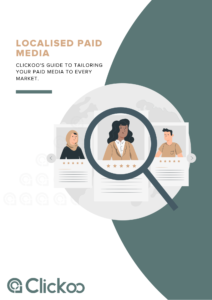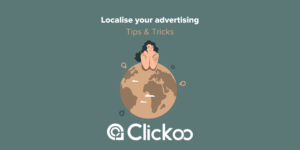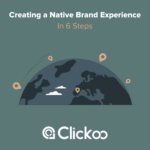There’s a lot more to localisation than putting the occasional cultural reference in your advertising.
To truly connect with your audience, you need to take a broader spectrum of market specific macro & micro factors into consideration – and act on them well. Check out this Hubspot list of 13 businesses with an excellent approach to global marketing.
Here, we outline how you can create a local approach to global marketing. You’ll be able to ensure you don’t waste any budget on ineffectual campaigns, and instead create a truly localised approach that’s built from the ground up around your audience.
Research your audience
At its core, data-led digital communication is like conversation. With both the brand and the customer receiving, interpreting and responding to information (like ad content, page scrolls or video views) as you would when in a normal conversation with a stranger, friend, or colleague.
And just like the more traditional conversations held between people, the best communications between you and your audience happen when you both know each other well.
If you don’t already know everything about your audience, it’s time to get familiar. The better you know them, the better the conversation will be. If you understand the questions they are likely to be asking, and you’re able to provide the answers to those questions, they’ll have the best experience possible. And so research is essential if you want to have the greatest conversations, and therefore, campaigns that generate the best results.
Understanding how your audience acts in terms of buying is key. This will range from one country to the next – with different motivations, thoughts and steps involved in their decision-making process. How they discover your product or service can also vary as a result.
They might not even discover you through online advertising – whilst its popularity is skyrocketing, it’s taking over some areas of the world more than others. Whether individuals respond to social media advertising or not can really fluctuate too.
You’ll also need to think about how to target your message accordingly. Different audiences can contrast in how they react to conversational techniques like facts, figures and emotions.
Markets can even vary in their interpretation of different colours, with the same colour representing health and prosperity in some markets, and death and intimidation in others.
Analyse the wider environment
Next, look at the factors impacting the broader market environment your audience is in. Market size is important in assessing the scope of opportunity, together with whether your product is already known or not. It might be that there are no current competitors for your offering – but is that because it’s truly innovative, or is there no demand for it?
Legislation is a substantial influence too. The type of advertising you carry out in one country may be prohibited in another. There may also be taxes to be aware of – not to mention, you’ll need to think about how customers prefer to pay. In some countries, like Germany, using a credit or debit card isn’t as popular as payment methods like instant bank transfers.
Then there is seasonality. Whilst retail sales in the UK are a regular occurrence, other countries have mandatory periods in which sales are permitted. Business downtime, too, isn’t a thing in Britain apart from during national holidays. But in countries like Italy, businesses in certain industries can shut down operations for weeks at a time during Ferragosto – definitely not a factor you’d want to miss out of your digital strategy!
These broader market factors impact search trends and engagement metrics and have a knock-on effect on any advertising running in that territory.
Know how you should speak
Before you create your ads, it’s important to define your brand’s tone of voice. But you’ll have to think beyond simply your business’ personality and values in its native tongue – your chosen writing styles and ways of speaking will need to properly resonate in a different language and to a different audience too.
With European languages, for example, the usual words you would use to speak either formally or informally can vary. In Germany, both ‘du’ and the more formal ‘Sie’ mean ‘you’. Knowing which situation requires which approach is critical, as getting it wrong can have the power to offend. If you’re ever in doubt, use ‘Sie’ until the higher-ranking person (either by hierarchy or by age) uses ‘du’ in conversation.
Provided you don’t use ‘du’ unsolicited, German customers generally value directness over politeness. Therefore, it pays to get to the point quickly – even if it’s an awkward topic or product, like those related to sexual health or bathroom habits. Small talk simply isn’t a thing in Germany – they think it’s hilarious how much British people chat about the weather!
Consider all your channels
The main market channels can dramatically contrast by territory. For instance, Pinterest is only really just beginning to emerge in the UK, yet is wildly popular with US audiences, and the number of young people using Facebook in Germany is declining.
Search platforms are different too. Whilst Google holds around 93% of the British market, this isn’t the same story in all countries – in the US, Bing holds around 50% more of the search engine market than it does in most European countries. Then there are video content platforms like YouTube, which can reach as much as 81% of some key demographics (15-25 year olds in the US) – not hard to see why it’s fast becoming an irreplaceable part of many digital strategies.
And it’s not just your ad channel strategy which will require localisation – everything your audience could come across as a result of your campaign will require careful consideration. If you’re linking back to your website or a landing page, think about the use of your slogan, imagery, colours and any symbols – these may not resonate with your audience in a different country, which will most likely mean missed targets in that territory.
Don’t do it all yourself
As you can probably tell by now, pulling together and building a localised approach based on all these insights is no easy task. That’s why partnering with international paid media experts can be invaluable. They’ll have all the knowledge, experience and resources at hand – not just for gathering the right information, but also to effectively bring it together to create a hyper-targeted local market strategy.
Ideally, as well as successfully localising your advertising, they should continuously be searching for further opportunities for growth too.
At Clickoo, as pioneers of the localised approach to paid media strategy this is precisely what we do – Growth centric, audience first paid media strategy tailored to your target market.
Localisation truly is our heart. We’ll work with you to create hyper-targeted paid media campaigns that are built to grow your brand internationally.
Take this chance to utilise our paid media knowledge and cross boundaries – both physical and otherwise. Speak to the Clickoo team today.
Want to learn more about a localised approach to paid media advertising?

Fill in the form below to get your copy of Clickoo’s guide to Localised Paid Media.



